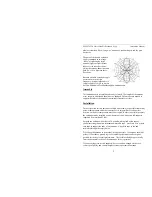
MFJ-1742 20 Meter Double Extended Zepp Instruction Manual
1
INTRODUCTION
The MFJ-1742 is center fed wire antenna that, when properly erected and fed
with balanced feedline, will give up to three decibels (dB) power gain on the 20-
Meter amateur band, along with directivity broadside to the antenna. In addition,
with a proper antenna tuner it will also give good results on all amateur bands
from 5 to 50 MHz. It also will work acceptably well on the 3.5 MHz band,
although it is somewhat shorter than a half wavelength. This antenna will handle
1500 watts of RF power (with a suitable antenna tuner). Its total length is
approximately 84 feet.
Center-fed wire antennas, when extended beyond a half wavelength in length,
begin to exhibit gain and directivity over a halfwave dipole. Such antennas are
called collinear arrays, and their gain and directivity increase as their length
increases, up to a point.
The simplest of these collinear
arrays is a centerfed antenna one
wavelength long, called “two half
waves in phase” or a “Double
Zepp.” Such an antenna has about
1.6 dB of gain over a dipole.
An
extended
double Zepp (figure
at right) is longer: 0.64
wavelengths per side, or about 5/8
wavelength per side. The formula to determine the length of each side in feet is
599 divided by the frequency in MHz.
This antenna has some 3 dB of gain over a dipole on 20 Meters. A technical
discussion of how this antenna works is beyond the scope of this manual, but, in
simple terms, at 0.64 wavelength per side the current points of the wires are
moved out from the feedpoint, providing electrical spacing between the two
sides (elements) of the antenna. This results in gain and directivity.
Unfortunately, increasing the leg lengths beyond 0.64 wavelength makes the
WARNINGS: Always mount antennas so that they are out of
the reach of adults and children. Contact with any part of
this antenna can cause RF burns or other injuries.
Constructing or erecting antennas where they may contact
electrical power lines can result in injury or death.





















